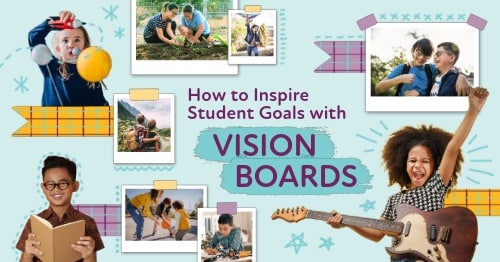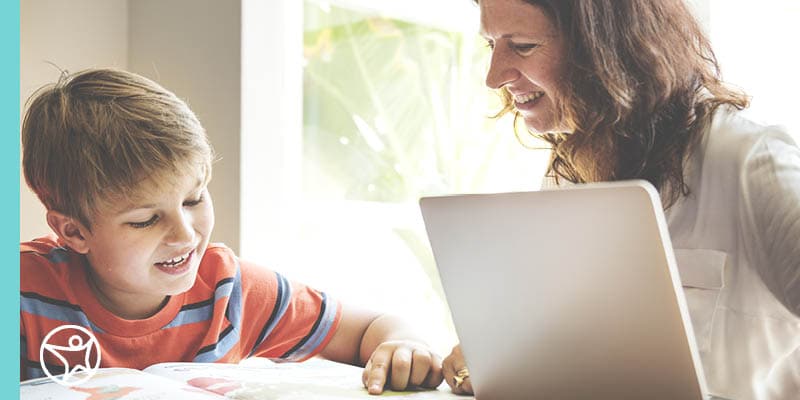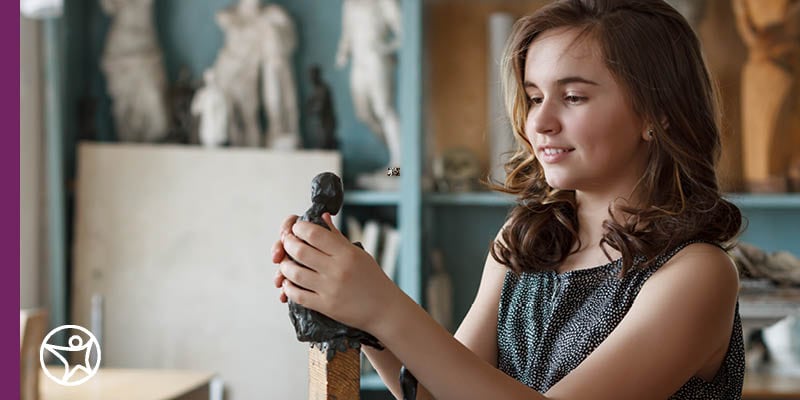How to Inspire Student Goals with Vision Boards
byNell Gladson
5 min to read
Goals are unique to every student—and can sometimes be difficult for them to imagine, let alone put into words. This is where vision boards can can serve as a creative way to help students picture ambitions and to inspire the actions needed to achieve them.
What Is a Vision Board?
A vision board is a collection of images, quotes, words, objects, art, or doodles that represent a person’s dreams, goals, and aspirations for the future. It’s most often created on posterboard or digitally in a collage format built from curated images, text, and other materials.
Vision boards are used to help students think through what they want their futures to look like and set meaningful goals. Vision boards also serve as a way for them to visualize their definition of success and can become a personal roadmap to keep them on track.
How Can Vision Boards Benefit Students?
Vision boards can benefit students by:
- Allowing time and space to focus. The number of distractions students face today—from smartphone apps to relationship dramas—can rob them of the focus needed to envision their future. Creating a vision board gives students space to put all their attention on their personal aspirations. The completed vision board then serves as a reminder for them to regularly take time to focus on their goals.
- Helping to jumpstart SMART goals. A student’s goals can quickly dissolve if they’re vague or unachievable. Vision boards can be a jumping off point to help them move from big dreams, like becoming a doctor, to SMART goals like taking an advanced biology class.
- Fostering a growth mindset. Students with a growth mindset — a belief that their abilities, intelligence, and talents can change for the better over time — tend to push themselves out of their comfort zone and on to new challenges. Visualizing their dreams in a creative way can help develop a growth mindset by increasing their awareness of what inspires and intrinsically motivates them.
How to Make a Vision Board for Students
Making a vision board for students is a straightforward process that requires thought, time, and some basic craft supplies or image editing software. recorders, timers, and text-to-speech software.
What to Put on a Vision Board
When it comes to deciding what to put on a vision board, the sky’s the limit. As a Learning Coach, you might want to encourage your student to make a vision board that relates to their school, personal, or career goals. Or you can leave the purpose open-ended to include any dream they choose to imagine—like going to the Super Bowl or connecting more to nature.
Whether practical or aspirational, there’s no right or wrong way to vision board; just keep in mind that the project’s purpose should be to create something that inspires students to clarify and stay focused on their goals.
4 Steps for Making a Vision Board for Students
Follow these four simple steps for creating a vision board for students:
1. Explore Students’ Vision Board Examples for Inspiration
It can be helpful for students to see what the final product looks like, especially if they have never made one for themselves before. Many examples of vision boards and templates can be found on Pinterest through their site search.
2. Give Students Time to Think About Their Aspirations
For a vision board to have meaning, there needs to be a fair amount of student time spent thinking about goals and dreams. Ways to facilitate that include:
Prompt them with grade-appropriate questions such as, “What color makes you feel positive?” or “What is your dream job?” Have them write down the answers.
Ask them to write a journal entry about what motivates them, where they see themselves in the future, and what gives them joy.
3. Gather Your Vision Board Supplies
You’ll need some basic supplies to get started on a vision board, including:
- A base to create the board on such as posterboard, corkboard, or a whiteboard. Or if going digital, a blank canvas in a photo-editing software or app.
- Scissors.
- Something to secure images to the board, such as tape, glue, or pushpins.
- Magazines, photographs, quotes, or other items that can be snipped and pasted.
- Colorful markers, crayons, or pencils.
- Any small objects that spark creativity such as stickers, beads, or ribbon.

4. Get Them Working on it and Display
Start by letting them choose the images and objects they want to use to visualize their dreams. Then, let them create the vision board under their own direction.
Getting the Most Out of a Vision Board
The point of a vision board is to inspire action. To do that, it needs to be visible. Don’t let students stuff it in a drawer. Instead, ask them to put it in plain view to give them daily motivation.
Some good places to display a vision board include:
- Hanging it on the wall next to their home study area or bed.
- Laminating it to make it a binder cover.
- Using it as a wallpaper on their computer or phone screen.Magazines, photographs, quotes, or other items that can be snipped and pasted.
Seeing their vision board every day, even briefly, can help keep them focused on their goals and better remember what they are working towards.



